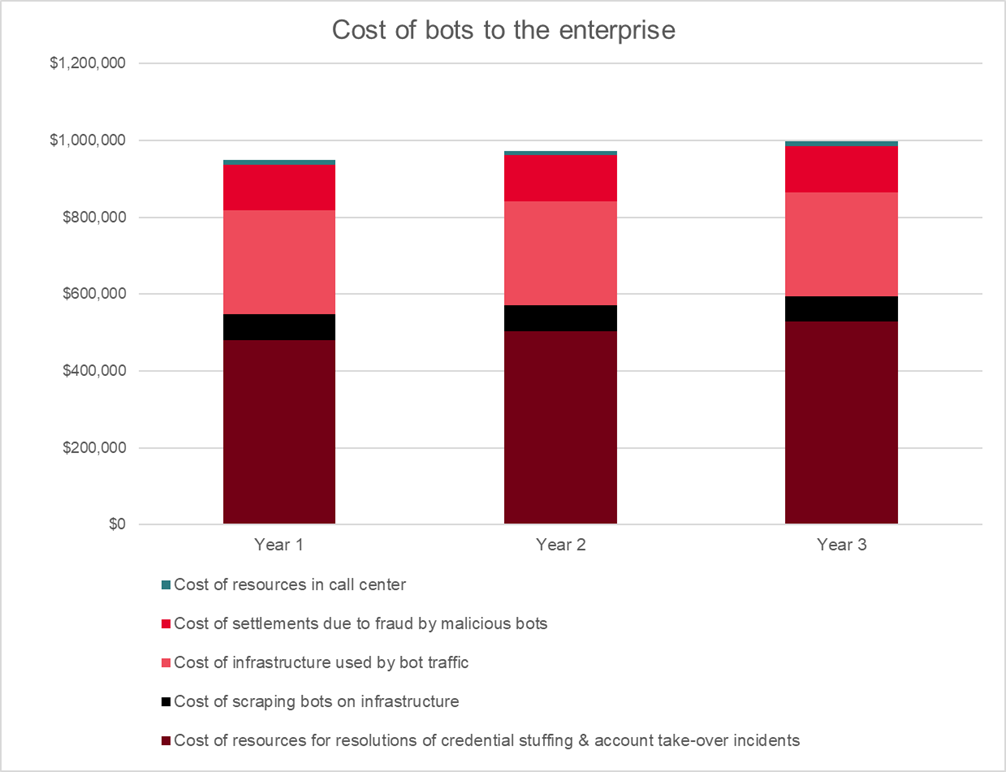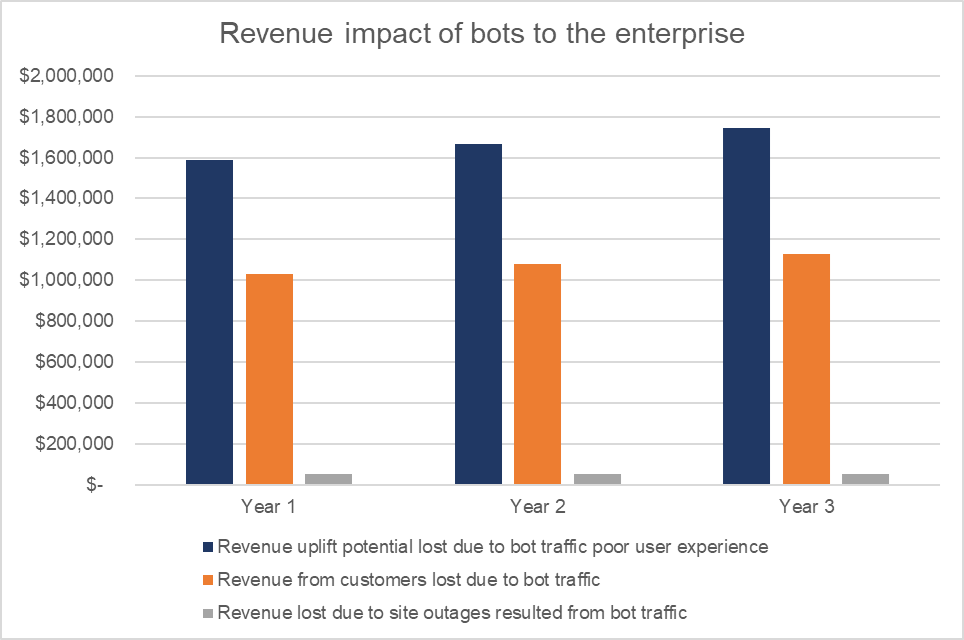Compreendendo o impacto comercial dos bots
Enquanto os esforços de transformação digital continuam a acelerar, os setores enfrentam um grande desafio: garantir a segurança dos aplicativos contra bots maliciosos para minimizar o impacto nos negócios. Reunir os recursos para atingir isso exige explicar ao seu conselho e à alta gerência os impactos quantitativos e qualitativos que os bots têm no seu negócio.
Como parte interessada da empresa, você sabe que ataques de bots maliciosos são mais do que uma ameaça à sua infraestrutura de segurança: eles representam um desafio empresarial que deve ser enfrentado para preservar as operações e a viabilidade fiscal da sua organização. Os bots colocam em risco suas iniciativas de experiência do cliente, arriscando perda de receita, aumentando o custo de conquista de novos clientes e fazendo com que você perca oportunidades de vender produtos e serviços. E, de acordo com o Relatório de Impacto Econômico Total da Forrester , as equipes operacionais podem desperdiçar até 10.000 horas na proteção manual de bots.
De fato, os danos causados por bots maliciosos são tão variados que pode até ser um desafio explicar os custos extensivos para os líderes empresariais da sua organização se eles não estiverem familiarizados com o cenário de ameaças.
Além disso, cada organização é única. Embora pesquisas de mercado genéricas possam explicar o impacto dos ataques de bots e os benefícios comerciais da mitigação de bots, essas pesquisas podem não refletir as realidades distintas do seu negócio. Como você pode comunicar o impacto econômico de bots maliciosos de uma forma que reflita seu próprio caso de negócios?
Para fazer isso, vamos rever um exemplo concreto de uma organização que se esforçou para criar tal caso de negócios e ver o que eles aprenderam.
Estudo de caso de mitigação de bots
Para ilustrar o valor financeiro do gerenciamento bem-sucedido de bots, considere o seguinte exemplo do mundo real baseado em uma consultoria realizada pela F5 para um grande varejista com sites de compras online e em lojas físicas. Com mais de 30 milhões de contas de usuários e uma receita média mensal por conta de usuário de cerca de US$ 50, a ameaça de bots maliciosos para este varejista dificilmente era um problema comercial trivial.
A atividade de bots maliciosos levou a maiores gastos de tempo, esforço e recursos de suas equipes de TI e operações. As explorações de bots incluíam incidentes de preenchimento de credenciais e aquisição de conta (ATO) que precisavam ser resolvidos, exigindo o esforço de uma equipe qualificada de segurança de TI e de call centers voltados ao cliente. Além disso, alguns desses incidentes exigiram reembolsos ou créditos, adicionando custos de liquidação às despesas operacionais.
Os custos de infraestrutura devido aos bots também estavam prejudicando os negócios. Embora a infraestrutura da empresa tivesse ampla capacidade para o tráfego gerador de receita, não havia como impedir o fluxo livre de bots maliciosos pela infraestrutura, o que esgotou os recursos de hospedagem na web do provedor de nuvem terceirizado da empresa. Os robôs de scraping — robôs que rastreavam o site constantemente para extrair dados competitivos — causavam interrupções no site e impactavam a experiência do usuário final, resultando em perda de clientes, perda de receita e perda de oportunidades de vendas adicionais. (Em um exemplo separado, a VegNonVeg teve custos adicionais semelhantes e resultados negativos devido aos raspadores.)
O varejista trabalhou com a F5 por meio de um exercício de modelagem de custo/benefício para calcular o seguinte:
Economia de custos: Aproximadamente US$ 1 milhão por ano em economia de custos operacionais por meio da mitigação mais eficaz de bots.
Impacto na receita: Com o gerenciamento aprimorado de bots, o varejista poderia economizar quase US$ 50.000 na prevenção de perdas de receita por ano devido a menos interrupções no site, e cerca de US$ 1 milhão em perdas de receita evitadas anualmente devido à redução nas contas de usuários perdidas e na rotatividade de clientes atribuíveis à experiência ruim do usuário.
Além disso, houve um aumento adicional de US$ 1,6 milhão na receita por meio de melhores taxas de conversão, resultantes de experiências de usuário sem atrito e clientes permanecendo no site por mais tempo.
Benefício total: Um benefício econômico total de aproximadamente US$ 11 milhões poderia ser obtido ao longo de três anos por meio de um gerenciamento aprimorado de bots.
Então, como você pode se beneficiar da modelagem de custo-benefício?
Para ajudar melhor os clientes a desenvolver uma análise de custo/benefício para mitigação de bots, a F5 desenvolveu uma ferramenta de modelagem baseada na web que utiliza uma ampla gama de entradas e produz um caso de negócios em uma linguagem que permitirá que você explique melhor aos líderes empresariais como estratégias aprimoradas de gerenciamento de bots podem ajudar a proteger os negócios da recessão.
Exemplos de insights de dados de custos e receitas incluem:
- Resoluções de aquisições de contas causadas por preenchimento de credenciais
- Relatórios de incidentes em call centers
- Custos de infraestrutura causados pelo tráfego automatizado
- Receita perdida devido a interrupções do site
- Impacto na receita de experiências ruins com a marca e o cliente
Inscreva-se para uma consulta gratuita sobre impacto empresarial de bots
Descubra quanto os bots maliciosos estão custando à sua empresa em fraudes, despesas de infraestrutura, esgotamento de funcionários e perda de clientes, inscrevendo-se para uma análise gratuita e abrangente do impacto dos bots nos negócios, personalizada para sua empresa e setor. Ou use a calculadora gratuita de impacto de bots hoje mesmo para ter uma visão geral do impacto comercial dos bots na sua organização.
Além disso, para aprender a comunicar melhor os custos que os ataques automatizados de bots causam à sua organização e os benefícios comerciais do gerenciamento bem-sucedido de bots, leia o white paper From Bots to Boardroom: Como bots ruins impactam negativamente seu balanço patrimonial .


